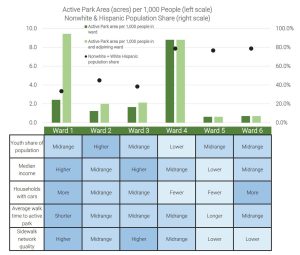
Why Do We Need a Public Space Management Plan?
Every city has policies and practices for how to improve, maintain, change, and acquire public spaces, like parks, sidewalks, urban plazas, suburban traffic management, public art, and so on. The City of Takoma Park is no different. It manages a constellation of formal policies, code regulations, City Council resolutions, and informal practices that determine where, how, and whether we devote resources in service of public space. However, the City has never taken a comprehensive look at its policies to identify where there are gaps, where there is redundancy, or where policies are working in opposition to the City’s goal of incorporating racial equity into all of our decision-making.
On a day to day basis, most residents may not notice much about public space management, other than whether the grass has been mowed in the park, or the trash cans have been emptied at the street corner. However, over time, policy choices and practices can lead to compounded issues that raise serious questions about equity. For example, in the draft Public Space Management Plan, the consulting team analyzed data about the amount of park space with activity-based amenities (such as playgrounds, ball courts, and workout equipment) in proximity to residents by ward. The findings were that the most diverse and lowest-income ward, Ward 5, also has the lowest access to active parks. Ward 6 was close behind. Findings like these invite city decision makers to reassess policies about playground and park upgrades, acquisition or creation of new recreational greenspaces, and strategies to create better walking and bike connectivity to such park spaces.
Occasionally, these gaps or frictions within our current public space management bubble up into challenging situations for community members and City staff, alike. In the absence of clear structures for decision-making or prioritization, budgetary resources may be overspent on projects that should have been a lower priority, City staff and leadership may need to scramble to pull together policies or take actions on short notice without thorough deliberation or data driving the process, or existing policies may be bluntly interpreted to address a new issue with unintended negative consequences. Each of these scenarios runs the risk of perpetuating an inequitable status quo that may have been handled more effectively, equitably, and thoroughly had a more comprehensive approach to public space management been in place.
To learn more about the recommendations for updated policies and a new decision-making tool in the Public Space Management Plan, visit the City’s project website: https://bit.ly/publicspacemanagementplan.

